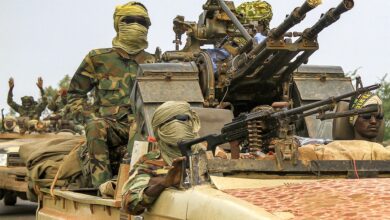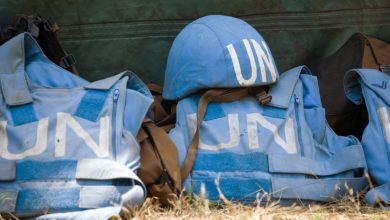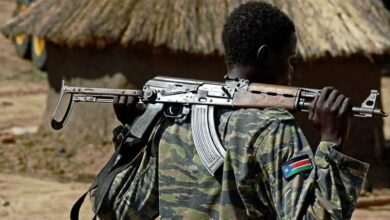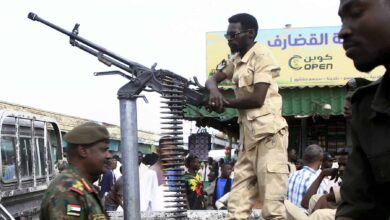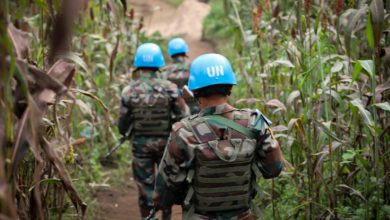The U.N. deployed air and ground assets in an operation to defeat what it said was an ex-Seleka milita “infiltration” attempt in Central African Republic.
“Following reports of a movement of elements of the Popular Front for the Rebirth of Central Africa (FPRC) between Ndomete and Dékoa…, the MINUSCA Force intervened in the locality on Friday, May 4, defeating the infiltration attempt,” the U.N. mission said in a Saturday press release.
Minusca said an attack helicopter engaged a pickup vehicle during the operation while patrols were also conducted on the ground. One “armed element” was arrested and AK-47 rifles, a large quantity of ammunition, rockets, uniforms and radios were seized.
Spokesperson Vladimir Monteiro told Radio Ndeke Luka that Minusca “received information about the presence of FPRC elements between Ndomete and Dékoa” on Thursday. Ground patrols and an Mi-35 helicopter were deployed on Friday.
The militia members had earlier circumvented a checkpoint in Ndomete by going into the bush, according to RJDH sources. Ndjoni Sango also reported that ex-Seleka had bypassed Ndometé.
Since late April, Burundian U.N. peacekeepers have enforced a vehicle checkpoint in Ndomete, around 10 km from Kaga Bandoro, preventing armed groups from moving towards Dekoa.
On Friday, CAR’s Ministry of Communication and Media said in a Facebook post that ex-Seleka militia had been attempting to move south from Kaga Bandoro towards Dekoa for several days. Dekoa is around 260 km from the capital Bangui.
The ministry said that Minusca helicopters “destroyed all the vehicles that were trying to move towards Dekoa,” adding that several militia members were “neutralised” and others were taken prisoner.
Also on Friday, Prime Minister Mathieu Simplice Sarandji said that “rebels who bypassed Ndomete” were “arrested by Burundian peacekeepers,” RJDH reported.
Government spokesperson Angel-Maxim Kazagui said on Friday that Minusca helicopters destroyed “five to eight” vehicles, Radio Ndeke Luka reported.
Dekoa local administrator, Guy Yves Mbetigaza, told Ndjoni Sango that five vehicles belonging to the rebels were “neutralized,” and that some militia members who tried to escape into the bush were captured by peacekeepers.
The U.N. operation between Ndomete and Dékoa is ongoing. The U.N. mission said ground and air assets are attempting to locate remaining militia members to “ensure that any attempts by the FPRC to go south is neutralized by the peacekeepers.”
Minusca said the operation is being carried out under its U.N. mandate to protect civilians and “eliminate any risk of destabilization of the country’s democratic institutions,” reaffirming that it will use all the means at its disposal inluuding force to protect and defend the “constitutional order” alongside CAR’s government.

Escalating tensions
Friday’s incident is the latest in a series that apparently began on April 1, when U.N. peacekeepers exchanged fire with members of an armed group in the mainly Muslim PK5 district of Bangui, the first attack on U.N. troops since violence resumed in the neighbourhood in 2017.
Minusca then launched a crackdown on armed groups in the PK5 enclave.
Between April 8 and 11, dozens of people including a U.N. peacekeeper were killed in clashes and more than 100 people were wounded.
According to Minusca, fighting began when a joint patrol of Rwandan U.N. troops and the Central African army was attacked on PK5’s outskirts during its Operation Sukula “disarmament and arrest” action against the 50/50 and Force armed groups.
The “self-defense” groups, comprised mainly of ex-Seleka fighters, were set up to defend against anti-balaka vigilante attacks, but recently they have been accused by some of intimidation and extortion. Minusca considers them criminal and says it will dismantle their bases unless they hand over their weapons.
Then, on Tuesday, at least 24 people were killed and around 170 were wounded in clashes in Bangui.
The sequence of events remains unclear, but it appears that a shootout began in PK5 after a militia member was arrested. A church in the Fatima district was attacked during a mass, reportedly with grenades and gunfire. A number of people were killed, including a priest, and others were injured. The violence then spread to the Lakouanga district, where a mosque was set on fire and two people were lynched.
Ex-Seleka rebels regroup
 Since April 13, heavily armed ex-Seleka faction members have been regrouping in several towns in northeastern CAR, notably in Kaga Bandoro, around 350 km from the capital.
Since April 13, heavily armed ex-Seleka faction members have been regrouping in several towns in northeastern CAR, notably in Kaga Bandoro, around 350 km from the capital.
The FPRC, one of the country’s largest armed groups, threatened to march on Bangui. The group said it wanted to act following Operation Sukula, saying that it singled-out Muslims.
Minusca spokesperson Vladimir Monteiro has repeatedly said Sukula is not an operation against Muslims. “The Muslim community asked our troops to launch the operation and put an end to the criminal activities,” he said on April 11.
Radio Ndeke Luka reported that members of other ex-Seleka groups – the Patriotic Movement for the Central African Republic (MPC) and the Union for Peace in the Central African Republic (UPC) – were also staging in the MPC-controlled town.
At an April 25 press conference, Minusca Police spokesperson Captain Leo Franck Gnapié said that a patrol intercepted a pickup truck in Kaga Bandoro two days earlier. Two people were arrested, and a rifle, 148 rounds of ammunition along with the vehicle were seized.

At the same press conference, military spokesperson Major Séraphin Embondza said that Minusca’s Commander, Senegal’s Lieutenant-General Balla Keita, travelled to Kaga Bandoro, Dekoa, Sibut and Paoua to determine the security situation and prepare for any threats posed by the FPRC.
Also on April 25, FPRC spokesperson Aboubakar Sidik Ali said discussions with other ex-Seleka factions were ongoing and that the option to move on the capital remains “on the agenda, since the government said the operation will continue.” The FPRC “must protect” the civilian population, Ali said.
The same day, RJDH reported a new ex-Séléka regrouping in Ndélé, northeast of Kaga Bandoro. Sidik Ali did not confirm the Ndele build-up, but said “we have a very large coverage of the territory, so we can regroup anywhere.”
A country beset by sectarian and ethnic violence
Resource-rich but one of the world’s poorest and most unstable countries, the recent unrest in Central African Republic began after Francois Bozize was overthrown in 2013 by the mainly Muslim Seleka rebel alliance.
Within months, Seleka was officially disbanded, but many fighters refused to disarm, becoming known as ex-Seleka. Many others joined the mainly Christian anti-balaka militia to fight the Seleka, leading to a spiral of violence between groups along both religious and ethnic lines in which thousands died.
By the end of 2014, the country was de facto partitioned – anti-Balaka in the southwest and ex-Seleka in the northeast.
President Faustin Archange Touadera, a former prime minister who campaigned as a peacemaker, was declared the winner of a 2016 presidential election perceived as crucial to transitioning from years of sectarian violence.
His weak government only controls around a fifth of the Central African Republic and relies heavily on Minusca for support. The rest is controlled by at least 14 different militia groups who often fight each other for control of revenue from extortion, roadblocks or mineral resources.
On April 23, Touadera said he wants to “accelerate” the disarmament of members of armed groups in Central African Republic, calling for more peacekeepers to be deployed, and for the U.N.’s Minusca mission to transition from peacekeeping to peace enforcement.
According to a February report to the U.N. Security Council, Minusca had deployed 10,665 military personnel, 90 percent of the total authorized strength of 11,650, as well as 2,044 police and 1,390 civilian personnel.
On April 26, Ivory Coast said it will send 450 troops to serve as peacekeepers. The U.N. is also seeking 900 extra troops to bolster Minusca, which the Security Council authorized in November.




